
Photo from wikipedia
Today, millimeter-sized nonspherical any-shape particles serve as flexible, functional scaffold material in chemical and biochemical reactors tailoring their hydrodynamic properties and active surface-to-volume ratio based on the particle's shape. Decreasing… Click to show full abstract
Today, millimeter-sized nonspherical any-shape particles serve as flexible, functional scaffold material in chemical and biochemical reactors tailoring their hydrodynamic properties and active surface-to-volume ratio based on the particle's shape. Decreasing the particle size to smaller than 100 μm would be desired as it increases the surface-to-volume ratio and promotes a particle assembly based on surface interactions, allowing the creation of tailored self-assembling 3D scaffolds. This study demonstrates a continuous high-throughput fabrication of microscopic 3D particles with complex shape and sub-micron resolution using continuous two-photon vertical flow lithography. Evolving from there, in-channel particle fabrication into a confined microfluidic chamber with a resting fluid enables the precise fabrication of a defined number of particles. 3D assemblies with various particle shapes are fabricated and analyzed regarding their permeability and morphology, representing convective accessibility of the assembly's porosity. Differently shaped particles highlight the importance of contact area regarding particle-particle interactions and the respective hydraulic resistance of an assembly. Finally, cell culture experiments show manifold cell-particle interactions promising applicability as bio-hybrid tissue. This study pushes the research boundaries of adaptive, responsive, and permeable 3D scaffolds and granular media by demonstrating a high throughput fabrication solution and a precise hydrodynamic analysis method for micro-particle assemblies.
Journal Title: Small
Year Published: 2022
Link to full text (if available)
Share on Social Media: Sign Up to like & get
recommendations!